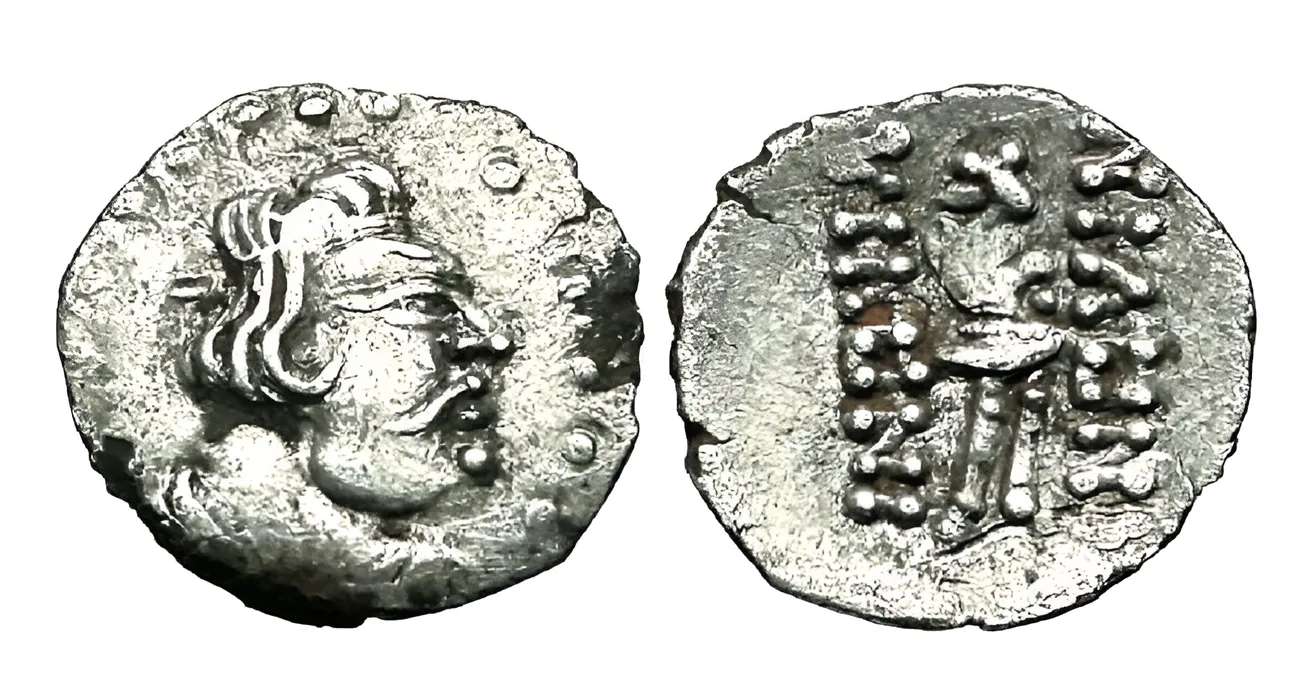
It is therefore no coincidence that they received attention from different generations of scholars, such as A. Cunningham, P. Gardner, J. Battaille, R. Ghirshman, L. N. Zograf, S. P. Tolstov, E. A. Davidovich, E. V. Zeimal, and J. Cribb among others. At the same time, the reading and translation of the inscription of the ‘Heraus’ tetradrachms, which is known to consist of four words, as well as its historical interpretation, remains largely controversial.
Before we proceed further it is appropriate to remember that the coins attributed by scholars to the Yuezhi ruler known in numismatic literature as “Heraus” (or “Sanab”), the first known coins bearing the term “Kushan”, represent the earliest evidence that the Kushan dynasty, founded by a certain Kushan, originated as the state of the Yuezhi.
There are two silver denominations of coins in the series in question: tetradrachms and obols. The tetradrachms bear on the obverse the diademed bust of the ruler facing right, and on the reverse the mounted ruler to right, crowned with a wreath by Nike (Victory) flying behind the ruler’s head. The obol obverse has the same design as that on the tetradrachms, while the reverse depicts a standing figure of a ruler or a deity (?). The legend is in Greek letters, placed on the back of the coins, and consists of four words on the tetradrachm and two words on the obol.
The Greek inscription of the tetradrachms varies on different specimens and has many variant readings (the legend has appeared in different forms and variations, often containing mistakes and misspellings). Most scholars, however, agree that the original inscription was as follows: ΤΥΡΑΝΝΟΥΝΤΟΣ ΗΙΑΟY ΚΟΡΡΑΝΟΥ ΣΑΝΑΒ which they, nevertheless, translate and interpret in different ways, for example: 1) “Of the supreme ruler (Tyrant) HIAOY, Sanab, (of) the Kushan(s)” or 2) “Of the Reigning (= Yabgu) ΗΙΑΟY Kushan Sanab” or 3) “Of the one being tyrant, ΗΙΑΟY, Kushan. Sanab.”
No less varied are views on attribution and dating of these coins, the latest finds of these coins indicating that they are far from being identical.
In particular, there are now known a number of ‘Heraus’ coins of the horseman type on which the winged Victory figure floating behind the rider’s head is absent, and the ruler’s portraits on the obverse are significantly differerent. Finally, there are now tetradrachms in which the Greek legend differs from that discussed above: in place of the Iranian word ΣANAB representing, according to V.A. Livshits, a short-form of either ΣANABAP or its genitive form in Greek ΣΑΝΑΒΟΥ, there appears the word ANTEIX, also possibly a short-form of its Greek genitive ANTEIXΟΥ.
At present, four specimens of the tetradrachms with ANTEIX are known: two published by J. Cribb and two by myself. In my article, I have presumed that the Greek word ANTEIX is a calque of the Iranian ΣΑΝΑΒ and that both of them may be considered as an epithet of the king issuing the coin, with the meaning “repulser of an enemy”, like the epithets standing along the names of Graeco-Bactrian kings on their coins: ΔΙΚΑIΟΥ – “the Just”, ΤΕΟΥ – “God-King”, ANIKITOY – “the Victorious”, etc.
You can learn more about the topic in the book-album "Kushan Kingdom: Dynasties, State, People, Language, Writing System, Religions" (XXXVI volume) from the series "The Cultural Legacy of Uzbekistan".
The general sponsor of the project is the oilfield services company Eriell-Group.
